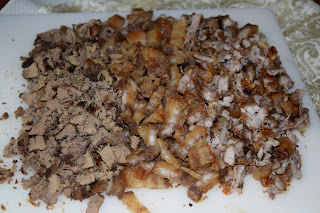 Lumpiang Shanghai
Lumpiang Shanghai is the most popular Filipino appetizer. This golden crispy tiny stick bursting in flavor, in terms of popularity is way up there with
pansit,
lechon and
adobo. The dish was introduced by the Chinese traders to the pre-Hispanic Philippines. Lumpiang Shanghai is different from Lumpiang Sariwa (Fresh Spring Roll.) The former is fried and the latter is not. See my recipe for Lumpiang Sariwa
here.
Fried lumpia is made with chopped vegetables such as carrots, cabbage, green beans and bean sprouts; and ground meat such as pork, beef, chicken or shrimp. It is flavored with garlic and onion; seasoned with soy sauce, salt and pepper; and wrapped in a thin crepe pastry called lumpia wrapper. The wrapper is made if rice flour.
It is served as an appetizer or snack and usually comes with dipping sauce on the side. The traditional sauce is the thick sweet and sour sauce made from a combination of water, vinegar and sugar. Other dipping sauces include: salt and vinegar; garlic, salt and vinegar; soy-vinegar sauce with or without garlic; and chili-garlic vinegar to name a few. It is commonly served as a finger food in every gathering and celebration.
Lumpia is similar to Indonesia's
loempia. Lumpia has been adopted not only by Southeast Asian countries like Vietnam and Malaysia but by European countries as well such as the Netherlands, Belgium, France and Denmark. In some Latin countries such as Venezuela lumpia was also introduced there by Chinese immigrants.
People who have visited the Philippines would have a clear recollection of lumpia if they have tried them. Filipinos, both adults and children love lumpia. My lumpia recipe is a version I learned from my grandma. It has minced shrimp. The flavor of the shrimp adds depth to the otherwise bland version with just ground pork in it.
Lumpiang Shanghai
Prep Time: 45 minutes
Cooking Time: 50 minutes
Yield: 50 pieces
Ingredients:
Lumpia Sauce: *
- 1 cup water
- 3 tbsp. rice vinegar
- 1 tbsp. banana catsup
- pinch of salt
- 1 tbsp. cornstarch dissolved in 2 tbsp. of cold water
Lumpia Filling:
- 1 lb. ground pork
- 1/2 lb. large shrimp, peeled, deveined and finely chopped
- 1 medium carrots, minced
- 1/4 cup Chinese celery, minced*
- 1 small yellow onion, minced
- 1/4 cup soy sauce
- 1 large egg
- 1/4 tsp. salt
- 1/8 tsp. freshly ground pepper
- 50 pcs. Lumpia / eggroll wrapper, separated and covered with damp cloth
- 1-2 cups peanut oil for frying
Garnish: sprig of parsley (optional)
Procedure:
Lumpia Sauce:
- Mix water, vinegar, catsup and salt in a saucepan. Bring to a boil. Lower heat and simmer for 5 minutes.
- Add the cornstarch slurry to thicken sauce. Simmer for 3 minutes while whisking.
- Remove from heat and transfer to a bowl to cool.
Lumpia:
- Mix all ingredients together: In a large bowl mix all lumpia filling ingredients except for the wrapper and oil.*
- Fill the wrapper: Lay one wrapper on a plate or clean work surface and spoon about a tablespoon of lumpia on it.
- Roll and seal the lumpia: Cover the filling by turning up the bottom corner of the wrapper. Fold in the left and right corners as if making an envelope. Roll the lumpia snugly yo ensure there are no air pockets to about half an inch in diameter. Seal the lumpia by dabbing the inside of the remaining corner with water or beaten egg.
- Repeat Step 3 until all wrappers are filled, rolled and sealed. (See Notes below for stoeage information.)
- Fry the lumpia: Heat oil in a deep fryer or skillet to 350 degrees. Fry the lumpia about 5 pieces per batch for 4-6 minutes until golden brown and the filling is fully cooked. Remove from the pan.
- Drain excess oil by putting fried lumpia pieces in a strainer over paper towels. (Or just simply place them over paper towels.)
- Transfer to a plate and garnish with a sprig of prasley. Serve warm with sauce on the side.
Notes:
* Make the sauce first before starting to fry the lumpia.
* If Chinese celery is not available, substitute with the soft part of a regular celery.
* The filling can be prepared a day ahead. Put in an airtight container and store in the refrigerator.
* To check the flavor of the lumpia mixture: cook a teaspoon of the lumpia filling in a pan with hot oil over medium heat. Taste and adjust salt and pepper.
* To facilitate efficient filling and rolling of the lumpia, separate the wrappers before starting to fill and cover with damp cloth to prevent them from drying.
* Uncooked lumpia can be stored in single layers in an airtight container in the refrigerator overnight or in the freezer for up to a month.
* Frying frozen lumpia will take 2 minutes longer than frying freshly wrapped lumpia.
* Fried lumpia does NOT store well. It gets soggy because of the wrapper.
* Fried lumpia may be served with different dipping sauces, too apart from the standard lumpia dipping sauce. These sauces include: salt and vinegar; garlic, salt and vinegar; soy-vinegar sauce with or without garlic; and chili-garlic vinegar to name a few.

















































